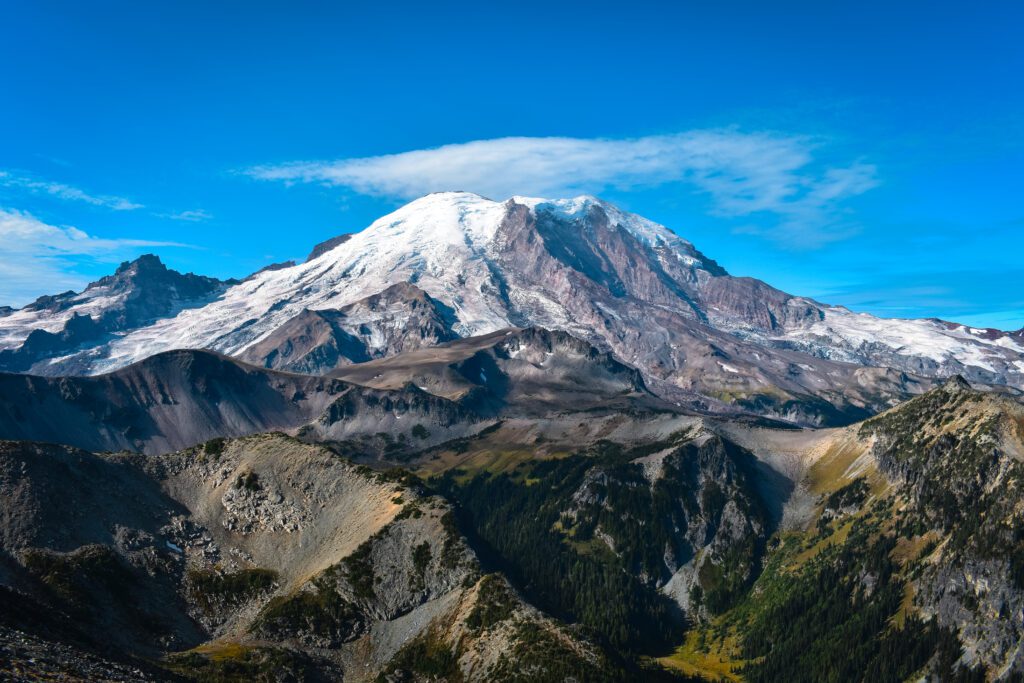
Nestled majestically in the heart of Washington state, Mount Rainier National Park beckons adventurers with its towering peaks and wild beauty. Mount Rainier is the most glaciated peak in the US and, as a result, has produced gorgeous terrain surrounding it. The rivers flowing from the glaciers have created the renowned wildflower meadows for which the National Park is famous for. Mount Rainier National Park also has some of the region’s most beautiful hiking trails, making it a top destination for outdoor enthusiasts. We spent a few days wandering around this enchanting park during our babymoon exploring the Pacific Northwest. As a result, I’ve created this Mount Rainier National Park guide so you can take advantage of all this park offers!
This post contains affiliate links, and I may earn a small commission when you click on the links at no cost to you.
When To Go
The park is open year-round, and each season offers a unique experience for its guests. I’ve outlined the options below in this Mount Rainier National Park guide.
Spring
Spring is a delightful time to visit Mount Rainier National Park as the temperatures warm up and the flowers begin to bloom. The melting snow causes the waterfalls to flow with thunderous amounts of water, and the blooming wildflowers start adding color to the park’s lower elevation areas. The weather can be a little unpredictable during the early half of the season, making it challenging to anticipate what hiking trails will be available.
Summer
The best time to visit Mount Rainier National Park is during the summer months. The weather is perfect for exploring the hiking trails, camping, and any outdoor activity you could imagine. Wildflowers are in full bloom, making the park look like something out of a storybook. The pleasant weather and families visiting on their summer vacations make for the largest crowds throughout the year. The accommodations book up quickly, and prices tend to be higher as a result.
Fall
Fall brings beautiful foliage as the leaves change color, especially in the surrounding forests. Compared to summer, the crowds diminish, making it a quieter time to visit. As a result, the prices for accommodations are also more reasonable. The weather becomes increasingly fickle towards the latter half of the season due to increased rain showers and cooler temperatures. This results in some outdoor activities becoming more limited, so it’s best to plan accordingly.
Winter
Once the snow hits Mount Rainier, it transforms the park into a winter wonderland, perfect for snowshoeing, skiing, and snowboarding. However, many roads and facilities within the park are closed during this time. Don’t fret if you plan to visit during the winter, though, since some designated areas remain open for winter recreation. While the landscape looks like a postcard, be prepared for cold temperatures and potential snowstorms.
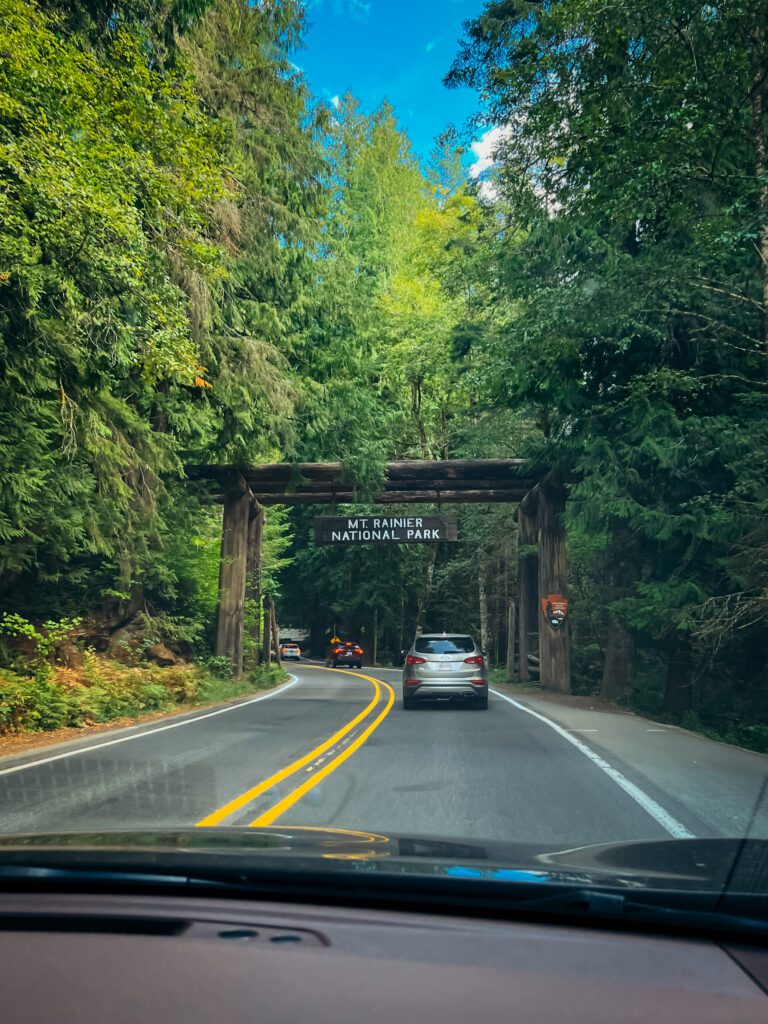
How To Get Around
Similar to other National Parks, the best way to get around is by driving or renting a car. Having your own vehicle allows you to choose your own adventure and set your own pace. It’s also important to note that the park currently offers no public buses or shuttles for its visitors. Mount Rainier is a sizable park, and it takes a considerable amount of time to visit each of the five sections. To get from the Henry M. Jackson Visitor Center in Paradise to the Sunrise Visitor Center takes an average of an hour and a half with no traffic. Be sure to budget extra travel time if you intend to explore the various areas of this beautiful park.
Know Before You Go
I’ve compiled some helpful information in this Mount Rainier National Park guide to ensure you have a smooth journey while planning your visit.
- The entrance fee for Mount Rainier National Park is $30 per vehicle, and each ticket is valid for seven days. They only accept credit card payments at this time.
- Mount Rainier National Park has four entrances: Nisqually, Carbon River, White River/Sunrise, and Stevens Canyon. The Nisqually entrance is the most popular due to its year-round vehicle access, proximity to state highways, and accessibility to Longmire and Paradise.
- Paradise requires a timed entry ticket reservation if you visit from May 24th until September 2nd. Sunrise also requires a timed entry ticket reservation if you visit from July 4th until September 2nd. Timed entry tickets are an additional $2 per corridor; you can book your reservation on the National Park Services (NPS) website.
- The Mount Rainier NPS website is full of helpful information and alerts. Hence, checking it throughout the day is beneficial to stay current on anything that could impact your experience.
- The peak time to visit and see the wildflowers is mid-July through mid-August. However, this depends on the weather and the amount of rain in the spring, so you may need to be flexible with your dates. The NPS website has a page dedicated to what’s currently blooming to learn more.
- Parking at Mount Rainier’s main attractions and popular hiking trailheads during the summer can be extremely challenging, if not impossible. I recommend visiting these areas on weekdays or arriving early in the day. Visitors are not permitted to park along the side of the road or anywhere that isn’t a designated parking spot.
- Due to the intense winter weather that impacts this region, many park roads close during winter. The only road that remains open is the road to Paradise, which closes nightly during winter months. NPS requires winter visitors to carry tire chains since road conditions are often icy.
- Given Mount Rainier’s elevation gain, cell phone service is spotty. We lost service nine times out of ten when driving throughout the park and on the trails.
- Mount Rainier is home to various wildlife species, including black bears and mountain lions. Although spotting these creatures during your stay is extremely rare, it’s essential to be aware of your surroundings and follow the wildlife safety guidelines.
If you need a comprehensive packing list for all your travel needs, I’ve got you covered! I created the ultimate packing list for your upcoming adventures, including carry-on essentials, toiletries, clothing, and location-specific items.
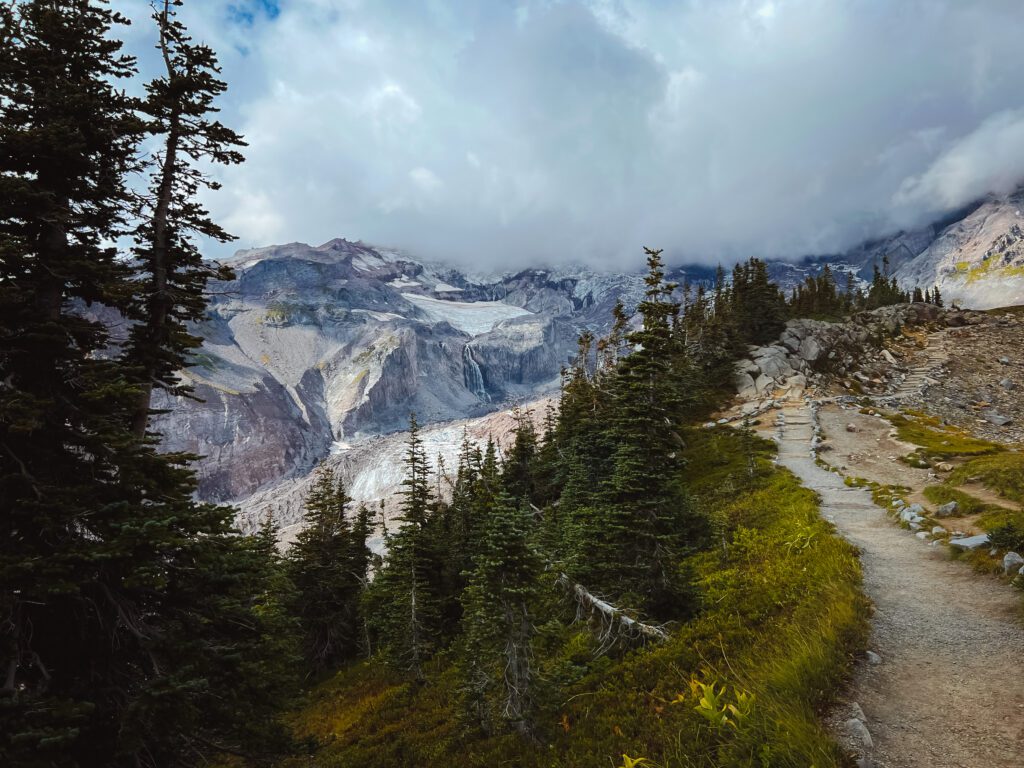
Mount Rainier Corridor Overview
Before you plan your Mount Rainier itinerary, it’s important to understand some basic park geography. The park has five sections: Longmire, Paradise, Sunrise, Ohanapecosh, and Carbon River/Mowich. Paradise and Sunrise are the two most popular areas because they are home to some of the park’s more iconic sites, hiking trails, and wildflower meadows. I’ve included a quick overview of each section in this Mount Rainier National Park guide:
- Longmire: The park’s historic region is home to the Longmire Museum, which is open year-round. This is the region where visitors can obtain wilderness permits and hiking and backcountry camping information at the Wilderness Information Center. It’s also home to the National Park Inn and gift shop.
- Paradise: This corridor is the most popular with visitors due to its remarkable views and colorful wildflower meadows. For an extraordinary experience within the park, you can book a stay at the Paradise Inn. This park corridor is open year-round and is home to the park’s main visitor center.
- Sunrise: When you arrive in Sunrise, you’ll be met by awe-inspiring mountain-top views. This region is the highest point in Mount Rainier National Park that can be reached by car. If you visit in the summer months, you’ll have a good chance of seeing wildflowers in the mountain meadows and epic views of Mount Rainier and Emmons Glacier.
- Ohanapecosh: This grand region is known for the complex old-growth forest towering overhead. Guests can wander among the Douglas firs, western red cedars, and western hemlocks. This corridor also has multiple family-friendly hiking trails and a great picnic area.
- Carbon River/Mowich: This corridor is known for its beautiful lakes and secluded hiking trails. Due to Mount Rainier’s high rainfall, this section of the park resembles a rainforest in certain areas. The road is unpaved in this region, which adds to the travel time needed to get to and from.
Where To Stay
Now that you understand the park’s main sections, it’s time to decide where to stay! Depending on the number of days you visit, I recommend staying around Paradise/Ashford or Packwood if this is your first trip to Mount Rainer. This will give you the best access to the more popular areas of the park without worrying about adding a ton of extra drive time to your day.
Paradise/Ashford Accommodations
During our trip to Mount Rainier, we decided to stay outside the park in the town of Ashford. Ashford is the town you’ll pass through when entering the park through the Nisqually entrance. This little hamlet is very small, but there’s a convenience store, gas station, and a few places to eat, which is all you really need. We booked a cabin with Betsy’s Cabins at Mount Rainier and had a fantastic stay. Each cabin includes a private bathroom, a kitchen with utensils and cooking equipment, and a hot tub. A few cabins have in-unit laundry, which is handy for extended stays. Our cabin was a cozy oasis for us to unwind after a jam-packed day of exploring the park. We spent our evenings cooking dinner, watching a movie together, and playing games! What more could you want?
Alternate Accommodation Options
If you’re looking to stay within the park or are looking for additional places to stay in Ashford, I’ve compiled some alternative accommodation options below in this Mount Rainier National Park guide:
Hotels & B&Bs
- Paradise Inn: This historic inn is named one of the “Great Lodges of the West.” It has 121 guestrooms with comfortable beds and a mixture of rooms with shared and private bathrooms. Onsite dining is available, and a piano player performs in the evenings, creating a relaxing atmosphere for the guests. Paradise Inn is only open from May until September each year, and there’s a steep price tag to stay at this lodge.
- National Park Inn: This relaxing 25-room inn is located in the historic Longmire District and a quick drive from the Paradise corridor. It is open year-round and has an on-site restaurant for its guests.
- Deep Forest Cabins at Mt. Rainier: This cozy collection of cabins is located in Ashford and offers guests excellent amenities, including outdoor hot tubs, games, a full kitchen in each cabin, and a fireplace to keep you warm.
- Stone Creek Lodge: This beautiful lodge offers cedar cabins with amenities such as hot tubs, gas log fireplaces, vaulted ceilings, kitchenettes, and large picture windows overlooking the garden or courtyard.
- Mt Rainier Little Red Cabin: This adorable reb cabin rental near Ashford has a fireplace, full kitchen, and outdoor deck adorned with a grill and seating. Enjoy a lovely evening watching the sunset with a glass of wine.
- Nisqually Lodge: This lodge is one of the few hotels in the area. The rooms are simple and clean and accommodate between two and eight guests. It’s five miles outside the park entrance, so you’ll quickly get to and from Paradise.
Camping
- Cougar Rock Campground: Cougar Rock is located near the southwest section of the park and gives you access to the Paradise corridor. Depending on the weather, the campsite is generally open beginning in late May and closes in early October. There are 179 individual sites and 5 group sites that are first come, first serve. You can book your reservation ahead of time on the Recreation.gov website.
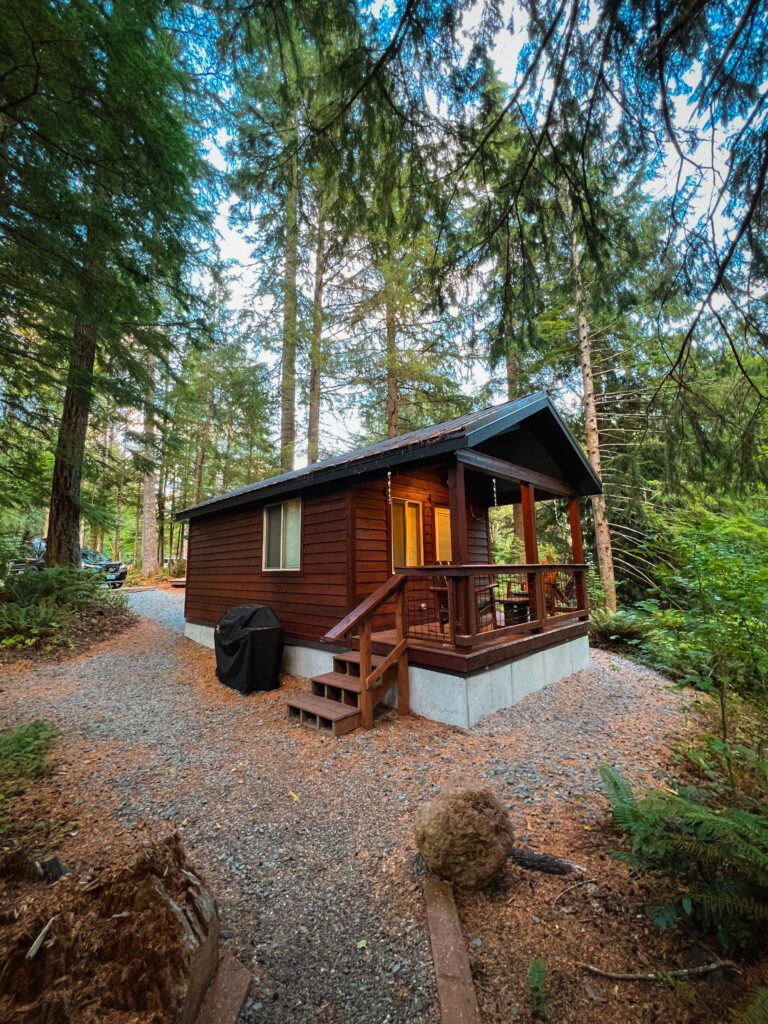
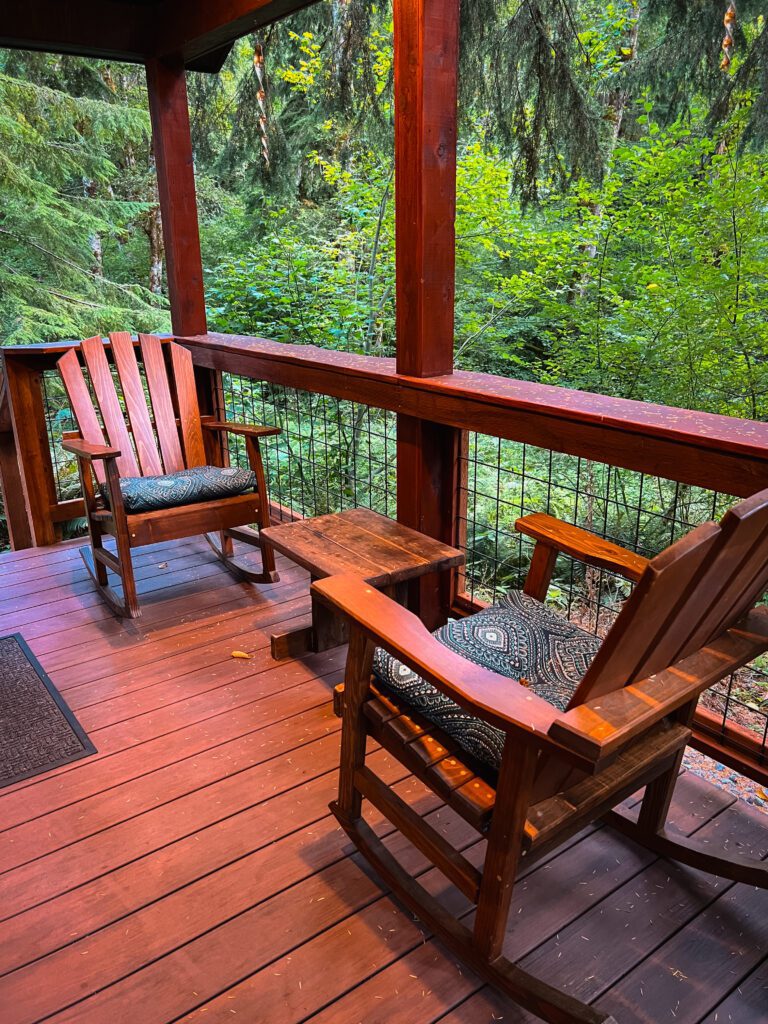
Packwood Accommodations
Packwood is another excellent location if you’re shorter on time and want to explore both Paradise and Sunrise. Similar to Ashford, Packwood is a small town with the basic amenities you need for your stay. The town is located outside the park and is roughly an equal distance between both areas, which can reduce extra drive time. I’ve included my top accommodation recommendations below in this Mount Rainer National Park guide:
Hotels & B&Bs
- Historic Hotel Packwood: This boutique hotel is full of cabin charm throughout. It was renovated in 2022 to add modern conveniences while staying true to its historic roots. There are nine rooms total, so booking ahead of time is recommended!
- Packwood Lodge & Cabins: Another recently renovated accommodation option in Packwood is Packwood Lodge & Cabins. You can book a room in their spacious lodge or one of their cozy cabins. I would personally secure a reservation in one of the cabins to take advantage of the hot tub and kitchen in each unit.
- Waterfront Cabin at White Pass and Mount Rainier National Park: This upscale cabin is a dream stay for those looking for a modern, clean space while being surrounded by nature. The panoramic windows in the living room allow you to take in the fantastic views while indoors. Or step outside to enjoy the sun terrace with the outdoor shower and hot tub.
- Cozy A-Frame with Hot Tub, Fire Pit, and Fireplace: This cute and cozy A-Frame is an excellent accommodation option, especially when traveling with a group. There are three bedrooms, one roomy bathroom, a hot tub, a grill, and a porch adorned with red Adirondack chairs that would be the perfect place to end the evening. Plus, it’s dog-friendly!
- The Cabin in Packwood: If you’re looking for a rustic cabin for your stay at Mount Rainier, this one would be a perfect option! It has two bedrooms, a kitchen, a washing machine, and mountain views from the front porch.
Sunrise Accommodations
Sunrise is in the northeast corner of Mount Rainier, the highest point in the park, accessible by car. When you arrive, you’ll be greeted by panoramic views of the majestic mountain without needing to leave your vehicle. The hiking trails in this region have some truly remarkable views to take in. The accommodation options around this area of the park are a bit slimmer, but I’ve compiled a list below in this Mount Rainier National Park guide if you choose to spend an evening in Sunrise:
Hotels & B&Bs
- LOGE Alta Crystal: You’re in for the ultimate mountain getaway at LOGE. This rustic resort offers guests the option to book one of its 23 suites or 4 cabins, each cabin with a private hot tub. In addition to the spacious rooms, there is a heated outdoor pool for those looking to take a dip regardless of the temperatures outside.
Camping
- White River Campground: White River is located near the northeast section of the park and gives access to the Sunrise corridor. Depending on the weather, the campsite is generally open beginning in late June and closes in late September. There are 88 individual sites, and they are first come, first served only.
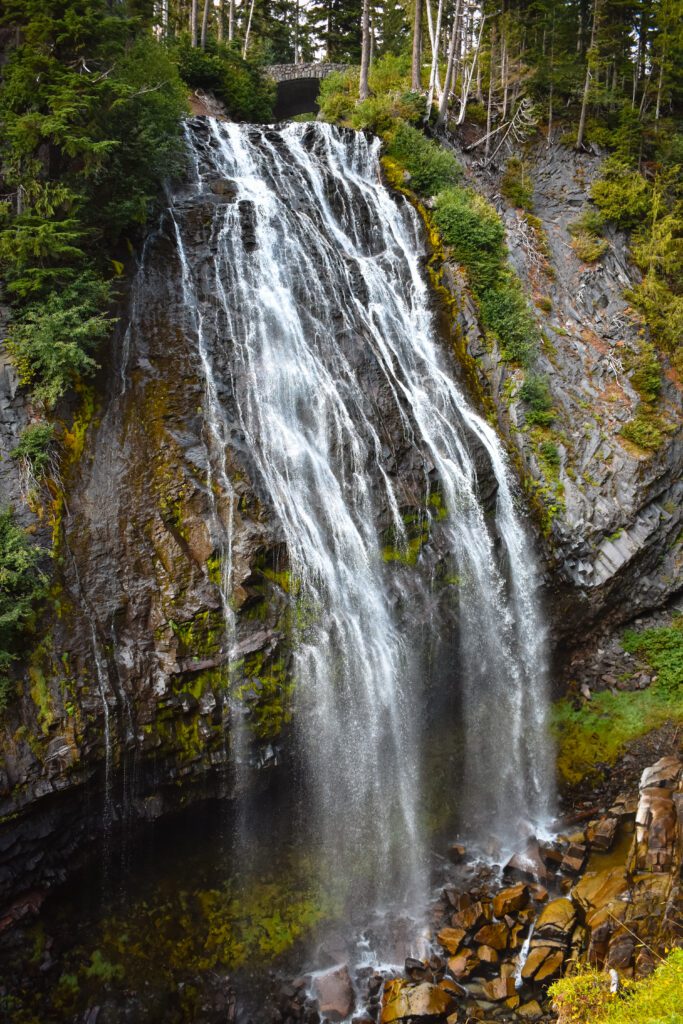
Main Sights
- Paradise: Immerse yourself in the breathtaking beauty of the mountain views and wildflower meadows, explore the history of the iconic Paradise Inn, and don’t forget to visit the museum upstairs at the Jackson Visitor Center.
- Sunrise: Witness the most remarkable views of Mount Rainier and Emmons Glacier without leaving your vehicle. Sunrise is also home to some of the most epic hiking trails throughout the entire park.
- Longmire: Explore the park’s rich history by visiting the Longmire Museum and National Park Inn.
- Christine Falls and Narada Falls: These two stunning waterfalls are accessible stops as you enter the park from the Nisqually entrance on your way to Paradise.
- Reflection Lakes: This tranquil spot is named for the serene lakes that reflect stunning views of Mount Rainier on a clear day.
- Tipsoo Lake: Another gorgeous alpine lake surrounded by wildflowers in the summer months is Tipsoo Lake. It’s a perfect stop on the beautiful drive between Paradise and Sunrise.
- Grove of the Patriarchs: Prepare to feel small as you stand among the grand old-growth trees and traverse the forest floor on this self-guided nature tour. You’ll cross suspension bridges and walk along boardwalks, taking in the beauty of the centuries-old trees.
- Mowich Lake: If you venture up to the Carbon River/Mowich cordorrior of the park, you’ll be in for a treat. Mowich Lake is set in a glacial basin and is Mount Rainier National Park’s largest and deepest lake. If you decide to hike the Tolmie Peak trail, it begins on the north side of Mowich Lake. This trail will give you the added bonus of witnessing the beautiful glacial lake Eunice Lake.
Mount Rainier National Park Guide Important Note: The Grove of the Patriarchs trail is currently closed while the suspension bridge is rebuilt.
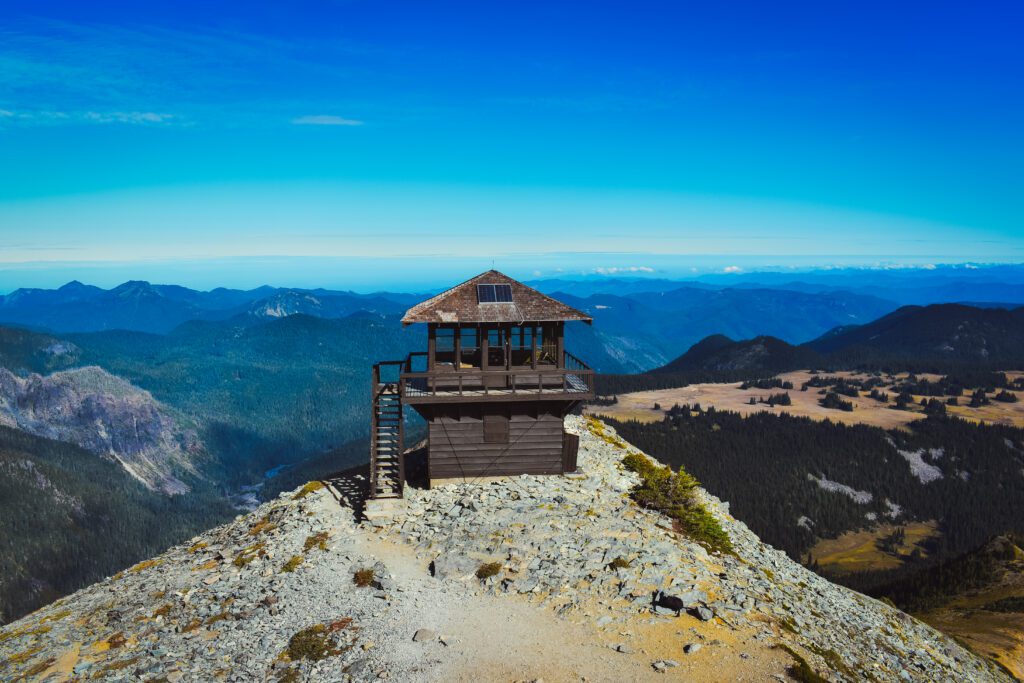
Mount Rainier National Park Hikes
If you’re visiting Mount Rainier National Park, odds are you’ll want to hit the trails to witness the beautiful views up close and personal. I feel you. Below, I’ve compiled a list of the top hiking trails in each corridor of the park in this Mount Rainier National Park guide. Don’t forget to check out the AllTrails app, which allows you to access the trail information and download the maps offline.
Paradise/Longmire Hikes
- Nisqually Vista Trail: 1.1-mile loop round trip, 180 feet elevation gain.
- Bench And Snow Lakes Trail: 2.2-mile out and back round trip, 449 feet elevation gain.
- Comet Falls Trail: 3.5-mile out and back round trip, 1,286 feet elevation gain.
- Rampart Ridge Loop Trail: 4.8-mile loop round trip, 1,417 feet elevation gain.
- Skyline Loop Trail: 5.7-mile loop round trip, 1,768 feet elevation gain.
- The Wonderland Trail: 85.8-mile loop round trip, 24,547 feet elevation gain.
Sunrise Hikes
- Naches Peak Loop Trail: 3.5-mile loop round trip, 659 feet elevation gain.
- Fremont Lookout Trail: 5.6-mile out and back round trip, 1,108 feet elevation gain.
- Burroughs Mountain Loop Trail: 9.5-mile loop round trip, 2,601 feet elevation gain.
Ohanapecosh Hikes
- Grove of the Patriarchs Nature Trail: 1.1-mile out and back round trip, 52 feet elevation gain.
- Silver Falls Loop Trail: 2.9-mile loop round trip, 521 feet elevation gain.
Carbon River/Mowich Hikes
- Tolmie Peak Trail: 5.6-mile out and back round trip, 1,555 feet elevation gain.
- Spray Park Trail: 6.9-mile out and back round trip, 2,198 feet elevation gain.
- Green Lake Trail: 9-mile out and back round trip, 1,466 feet elevation gain.
If you decide to hike, you should come prepared with a reusable water bottle and follow the Leave No Trace Principles.
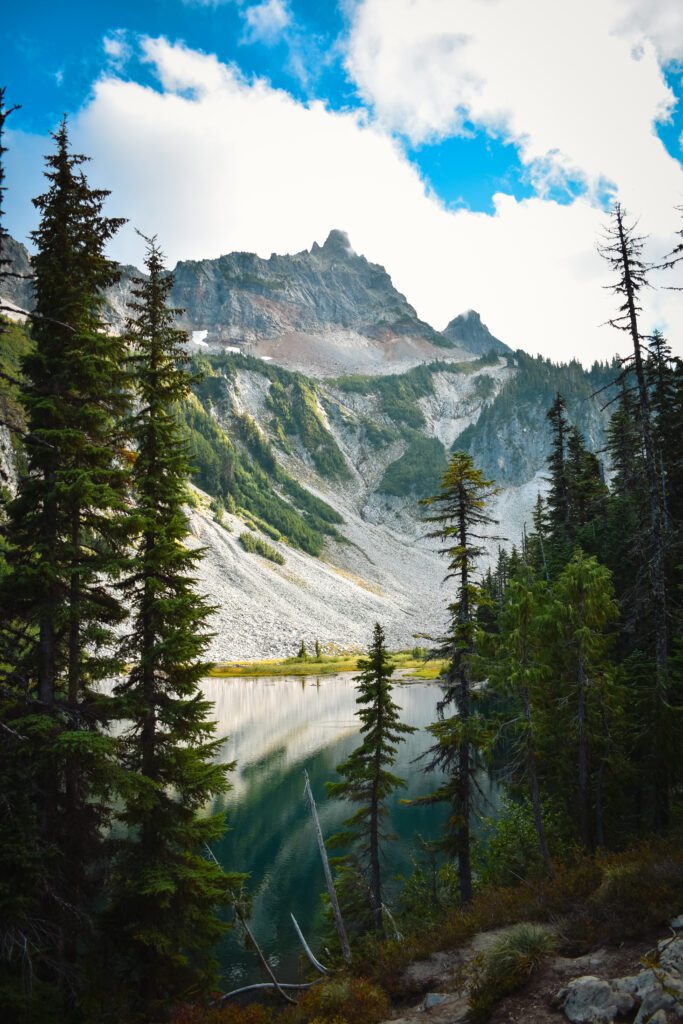
Weekend in Mount Rainier National Park Itinerary
The number of days you spend exploring a National Park is a personal choice! You may have just one day to visit the main highlights, or you can spend more time hiking a longer trail and exploring all the park’s corridors. I recommend spending two to three days on your first visit to Mount Rainier National Park so you have time to see the main attractions and hike some of the fantastic trails without feeling rushed.
I’ve created a weekend itinerary in this Mount Rainier National Park guide for all your planning needs! If you only have one day to explore, I recommend focusing on the Paradise corridor, as outlined on day one of the itinerary below. Let’s dive in!
Day 1 – Paradise
Prepare for an adventure as you enter the park from the Nisqually entrance. On your way into the Paradise corridor, stop and hike the Comet Falls Trail or the Rampart Ridge Loop Trail. Afterward, make two quick pit stops to check out the beautiful Christine Falls and Narada Falls. Both waterfalls require a brief walk to see the sites up close.
Once you arrive in Paradise, pay a visit to the Henry M. Jackson Visitor Center to obtain information about the park, the trails, and current conditions that could impact your experience. You can also ask the rangers where to find the wildflowers if you visit during the peak bloom months. Fuel up for the remainder of your day by eating a picnic lunch before hitting the trails again. End your day in the park by hiking the Skyline Loop or Nisqually Vista Loop. Both trails offer stunning views that Mount Rainier is well known for.
Plan on hiking in Mount Rainier National Park? Check out my Complete Hiking Packing List post that outlines the hiking ten essentials you need to pack for a safe journey outdoors.
Day 2 – Sunrise
You’ll want to get an early start on your day today as you head to Sunrise. If you stay in Ashford, getting to the Sunrise Visitor Center will take roughly two hours. If you stay in Packwood, it’ll take approximately an hour and twenty minutes. Don’t fret; the drive to Sunrise is lovely, and you may even witness some wildlife crossings on your way.
Once you arrive, you’ll be blown away by the views as you step outside your vehicle. Mount Rainier practically smacks you in the face with its beauty before stepping on a hiking trail. You can choose from an amazing list of stunning treks with incredible views – so you can’t go wrong with your choice! Fremont Lookout is one of the more popular trails in this park region, and it would be my personal choice for those visiting Mount Rainier for the first time. If you have energy on your way back towards Paradise, hike the Bench and Snow Lake Trail to take in the views of these two lovely subalpine lakes.
Another quick stop on your drive is the peaceful Reflection Lakes. No hiking is required, so it’s a nice break for your legs. As you return to the Paradise region, you can spend the rest of your day exploring the shorter trails and witnessing the colorful wildflowers around Paradise Meadows.
Day 3 – Ohanapecosh
On your final day, you’ll begin by visiting the Grove of the Patriarchs. This magical old-growth forest trail is an easy walk, and you’ll feel tiny compared to the massive trees above. Next, you’ll continue your journey to the Ohanapecosh area of the park, where you’ll fuel up by eating a picnic lunch at Ohanapecosh Picnic Area. After that, you can explore the lovely Silver Falls Loop trail. The trail is 2.9 miles long and passes by cascading waterfalls and moss-covered cliffs.
You’ll end the day by going to Tipsoo Lake for one final alpine lake experience before the weekend is over. If you still have some energy left, hiking the Naches Peak Loop that afternoon would be the perfect way to end your visit. This beautiful trail is only 3.5 miles long and has 659 feet in elevation gain. It’s very family-friendly, and the views are simply lovely! Once you’ve finished your final hike, you’ll return to Paradise before departing from the park until your next adventure.
If you have additional time to explore the park, I recommend spending a day or two in the Carbon River/Mowich region. That area has a few incredible hiking trails, and you can expect fewer crowds.
Final Thoughts
For the longest time, Mount Rainier National Park has been a bucket list destination for me. Now that I’ve finally visited, I fully understand the hype of this stunning national park. The hiking trails are remarkably beautiful, the meadows are lovely, and there are countless alpine lakes, which happen to be my favorite. If you’re planning a visit to Washington, I hope this Mount Rainier National Park guide helps you design the perfect adventure.
Have you visited Mount Rainier National Park, or is it still on your bucket list? Tell me in the comments!
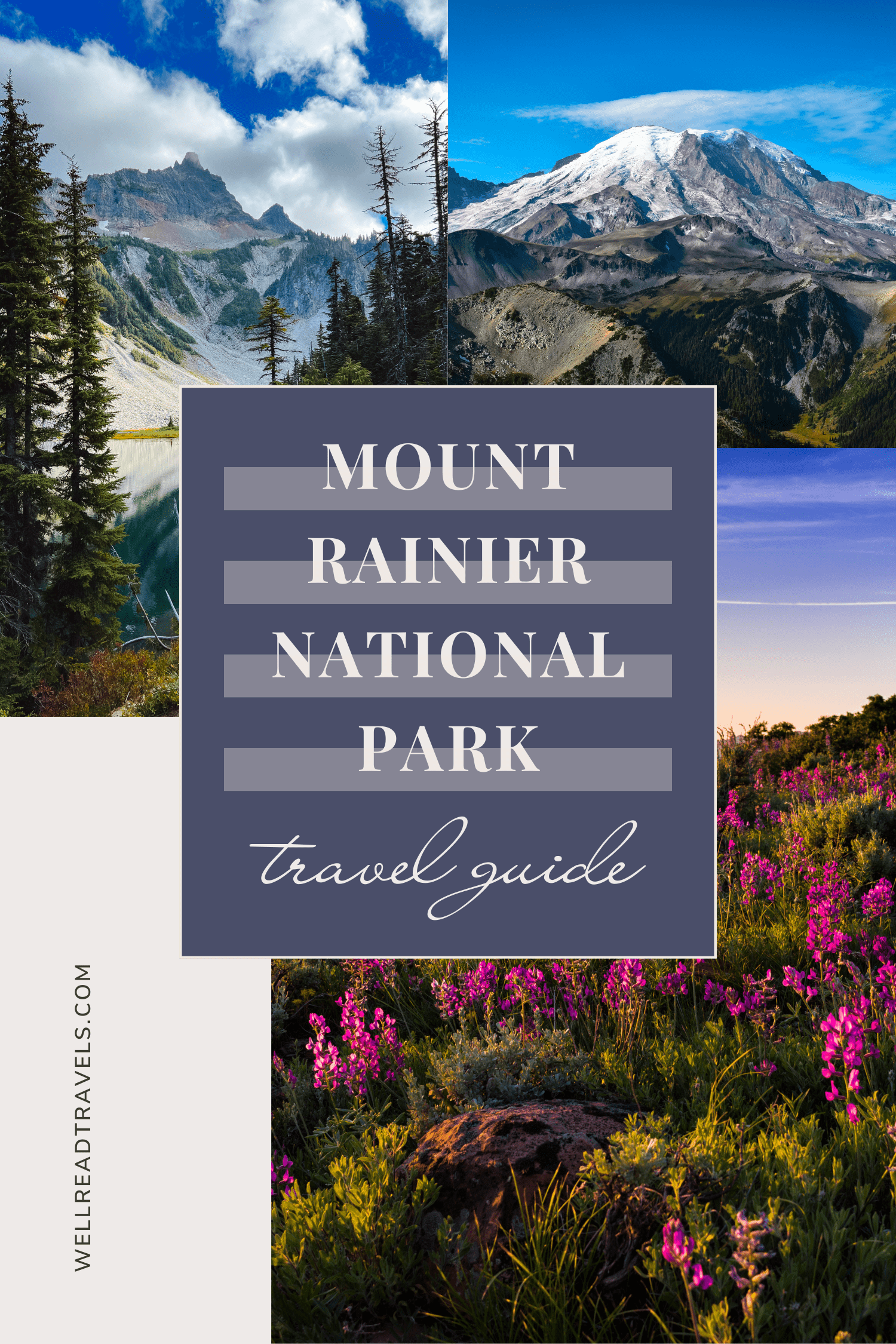
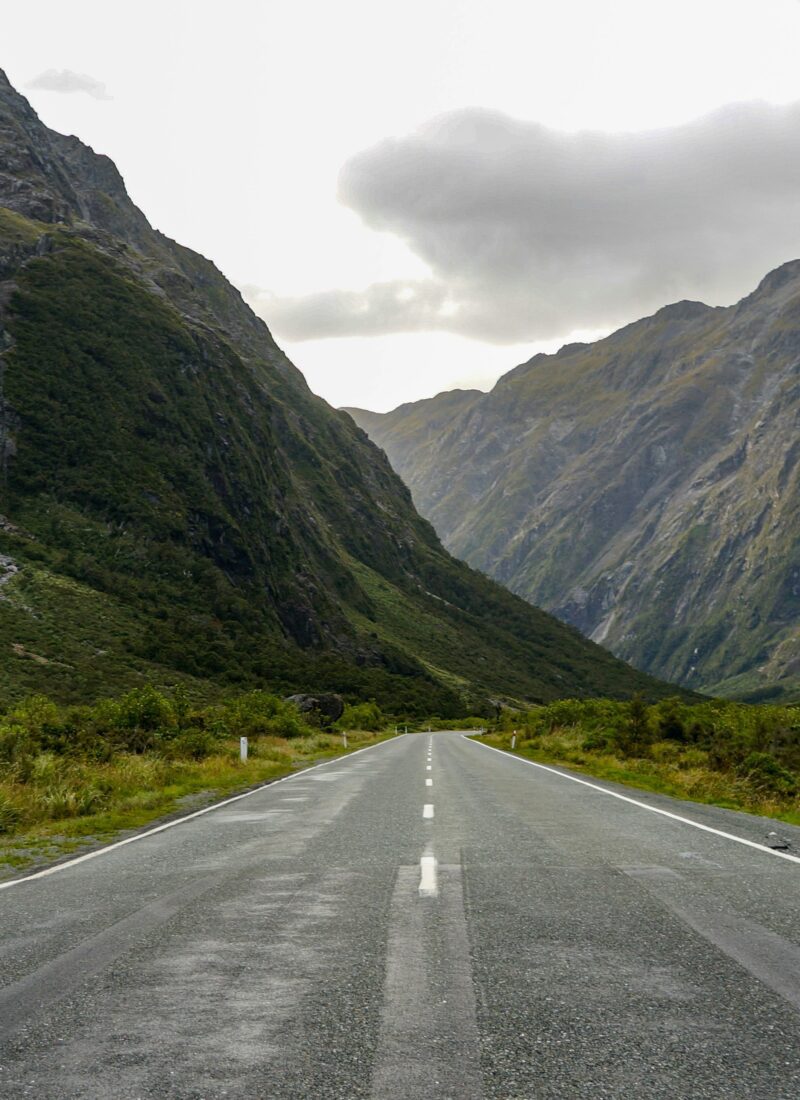

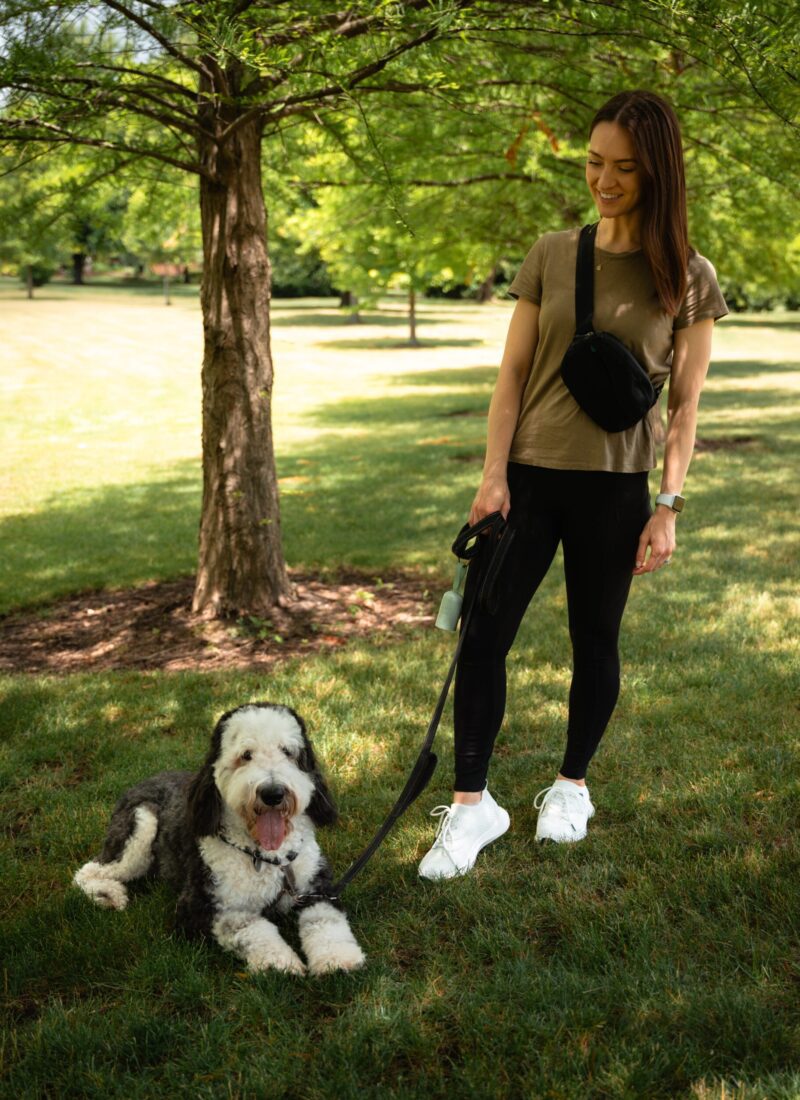
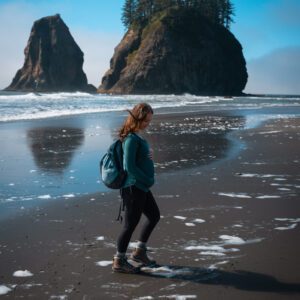

This is all such great information!! Can’t wait to use all this one day when I plan a trip there!!
I’m glad you found the guide helpful! I’m happy to answer any questions you have whenever you decide to visit 🙂